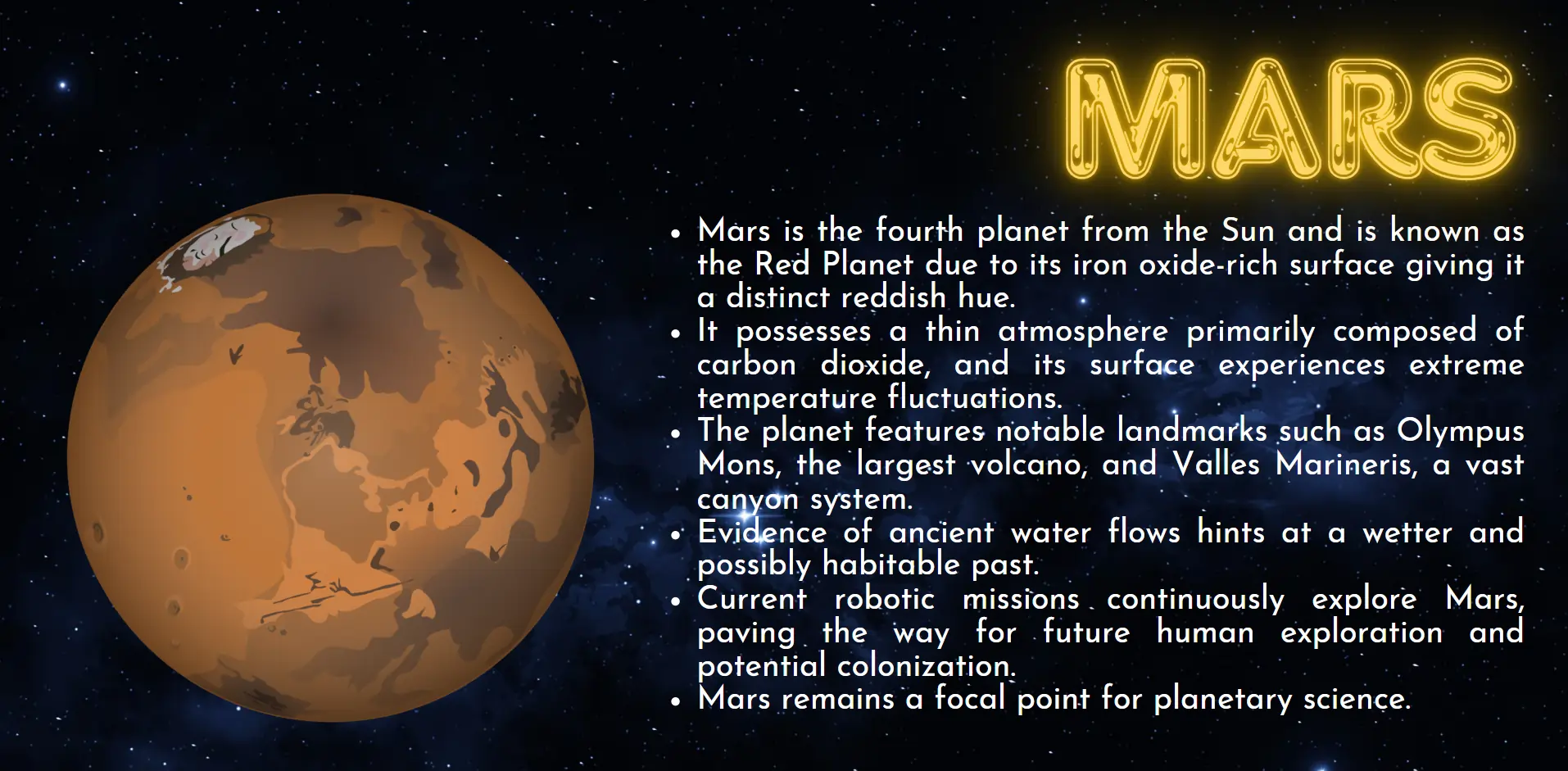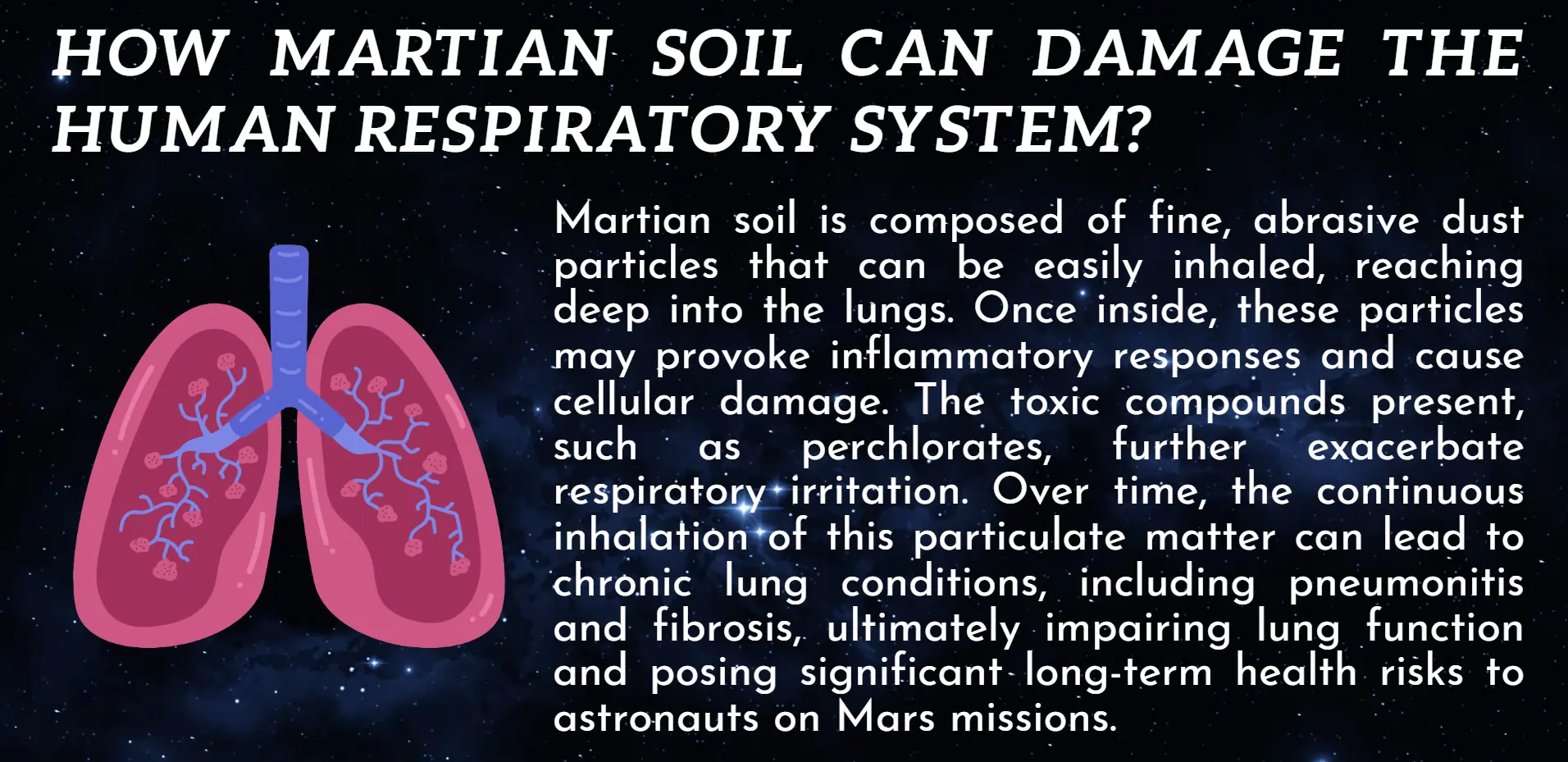Marital dust presents a greater danger to human health because of its super-fine composition that measures at 4 percent the size of human hair strands.

Humanity shows intense excitement regarding Mars exploration as our first mission to plant a human foot on the red planet draws nearer. People anticipate the Mars mission with great enthusiasm but danger emerges in the form of Martian dust. Terrestrial dust differs from Martian dust in multiple aspects because it exists in small quantities that contain unique chemical composition and wide distribution. Space explorers will face significant health hazards from Mars dust because it contains abrasive elements together with harmful perchlorates. The inhalation of Martian dust during extravehicular tasks together with its deposition within the habitat interior can ultimately cause various respiratory and chronic medical problems as well as skin irritations. Similar to its low gravity Mars maintains a thin atmosphere which allows dust clouds to increase contamination risks. The article explores how Martian dust stands beyond inconvenience to become an extreme obstacle which threatens astronaut safety and mission success. The research aims to develop strong protective measures which will secure the courageous explorers who advance toward this uncharted territory.
Understanding Martian Dust: Chemical Makeup and Fundamental Properties
Maritime dust consists of a particular composition and unique physical traits which makes it distinct from standard Earth dust particles. Under intense winds Martian basalt rocks break down to form silicate minerals especially pyroxene and olivine which continuous aeolian action grinds into distinctive small angular parts that constitute Martian dust. Hematite and iron oxides lead to the reddish Martian surface colour while it also enhances the chemical reactions of the dusty soil.
The findings from Martian orbital and rover analyses demonstrate that dust on Mars has comparable elements with Earth dust but displays dissimilar characteristics. Tests have discovered perchlorates which function as highly reactive oxidizing substances that raise health risks and acceleration of chemical processes. Dust from Mars also contains trace sulphates together with perchlorates which make its chemical composition more intricate. The small-scale dust particles when paired with these compounds become highly active in Mars' thin air environment since gravity's weak force and minimal air resistance makes it simple for particles to move throughout dust storm conditions.

Without water-mediated weathering the dust particles keep their rough edges leading to their high abrasive nature. The rough nature of the dust presents a threat to mechanical equipment integrity and spacesuits as well as habitat structures while the tiny dust particles enhance astronaut respiratory encounters. Future Mars mission protection of technology and health requires robust protective measures because Martian dust presents unique composition elements which combine reactive iron oxides with silicate constituents along with dangerous perchlorates.
The Martian Environment: Dust Dynamics and Exposure
The Martian environment features diverse harsh conditions whose dust dynamics determine surface contact mechanics and potential dangers. The thin atmospheric pressure of Mars along with its lower gravitational pull makes dust particles extremely evasive. Particular wind speed levels can release fine dust particles into extended travels due to the lack of atmospheric density to interrupt their flight. The planet experiences notable increases in dust mobility during its well-known dust storms which either affect broad geographical regions or cover the entire surface and create reduced visibility conditions as well as meteorological changes in local areas.
Fine dust particles accumulate electrostatic charges while these storms negatively affect them because of solar radiation and contact-based interactions. The electrical charges on the dust particles cause them to lunge onto surfaces that encompass equipment and habitat modules in addition to astronauts' spacesuits. Damaged machinery and delicate instruments experience mechanical abrasion because of the charged dust while it also hinders living space contamination control. The attachment of dust to surfaces continuously reduces air quality which presents harmful health risks to astronauts as they breathe contaminated air and encounter it through their skin.
The cyclical weather cycles of Mars become more intense because of its orbital pattern combined with seasonal changes. Mars's irregular yet powerful dust lifting patterns ensure airborne particles remain high in the atmosphere when dust lifting intervals decrease which leads to accumulation dangers for astronauts even when Mars appears settled down. The environment requires strong protective systems that include advanced dust-filtering technologies together with self-cleaning components and electrostatic protection methods to safeguard humans and equipment throughout Mars. The safe development of sustainable human settlements on Mars depends on an in-depth comprehension of Martian dust dynamic behaviour.
Pathways of Exposure for Astronauts
During Martian exploration astronauts will encounter various exposure pathways to Martian dust and this hazardous scenario will endanger their well-being along with mission accomplishment. The main route through which exposure occurs is by breathing in the dust. The clouds of fine particles created by extravehicular activities create such a threat to astronauts because they reach beyond current filtration standards. The tiny dust particles that people breathe in have the potential to avoid respiratory defences and cause short-term inflammation and prolonged pulmonary conditions.
People commonly develop exposure through skin contact with dust during their activities. Martian dust has gained its notoriety through its ability to be adhesive and hastily abrasive. The dust has the potential to reach skin areas both through contact with spacesuits and through unintentional cabin entry. Dermally exposed areas on the body become susceptible to damage from Mars dust which might also allow dangerous elements to compromise the skin protection.
Human eye vulnerability results in potential exposure risks. Stray dust particles have the ability to penetrate eyes both during extra vehicular activities and when astronauts remain inside the habitat. The low-gravity flight conditions combined with airborne dust suspension must be considered because they produce eye-related inflammation and vision problems together with tissue irritation.
Ingestion is another inadvertent pathway. Space explorers might swallow dust particles located on utensils or food items because these surfaces remain untouched thus endangering their gastrointestinal system health. Even though this exposure pathway requires multiple steps it is made worse by the presence of bioactive substances in the dust that could activate body-wide consequences.
Humans exposed to human-made habitat secondary aerosolization will experience additional time in danger from space microbes or other contaminants. Dust particles that remain following EVAs can eventually become airborne because of vibrations and air movement even if the personnel are unable to detect them right away.
Various methods of dust exposure on Mars emphasize the urgent requirement for innovative dust control techniques as well as advanced air filtering methods and strong decontamination procedures to ensure astronaut health protection.
Health Risks and current Research & Simulation Studies
The composition and physical properties of Martian dust lead to health risks that involve several different injury mechanisms. The primary danger to human health involves respiratory harm. Fine dust particles enter the lungs after bypassing natural Defense systems because of their sharp shape and irregular edges when individuals inhale them. Cells within the lungs will activate inflammatory systems that result in development of pneumonitis as well as persistent chronic pulmonary conditions. The risk is intensified when toxic perchlorates combine with reactive iron oxides because these compounds create cellular damage and oxidative stress.

The Martian soil threatens human health through contacts made during dermal exposures, exposure to eyes and respiratory system. Physical contact with Martian dust on raw skin areas or mucous tissues leads to distress, skin damage and toxic chemical burns. Such exposure to dust in the eyes creates immediate eye discomfort alongside inflammation and long-lasting injury requiring immediate proper medical treatment. The ingestion of dust through contaminated water and food inside Martian habitats creates an additional route for systematic toxicity to develop.
Researchers along with simulation experts are currently exploring solutions to health risks by developing tests on Martian dust conditions in Earth's atmosphere. Laboratories use Mars-1 JSC simulants to study Martian dust dynamics because these materials duplicate the true chemical composition of Martian dust leading to biological effect evaluation. Through animal research and cell culture tests scientists gained information about the fibrotic and inflammatory effects that result from dust exposure. Studies regarding space dust exposure play a crucial role in identifying the relationship between dosage and duration effects within isolation environments.
New simulation tests explore the behaviour patterns of dust when exposed to weightless environments. Recent studies analyze dust dispersal patterns in microgravity based on parabolic flight examinations and drop tower laboratory setups to evaluate filtration techniques that safeguard space crew. The study of dust particle toxicity on human respiratory functions utilizes advanced in vitro platforms through lung-on-a-chip systems. Such platforms enable researchers to study the Martian dust impact on cells and molecules through a real-time observation system.
The data from these research studies leads to the development of preventive strategies that consist of better air filtration, proper spacecraft sanitation and enhanced suits for exploration. The understanding of injury mechanisms grows stronger due to simulations and experimental studies which make astronaut health protection on future Mars missions more reachable.
Mitigation Strategies
The strategy for managing Martian dust combines present-day technological solutions with novel approaches to protect human health alongside equipment functions. The current methods used for managing Martian dust rely on strategic containment and filtration practices. Advanced air filtration systems used in spacecraft and habitats utilize HEPA filters together with electrostatic precipitators to eliminate hazardous fine dust particles preventing them from entering enclosed areas. Improved spacesuit technology includes protective dust-resistant materials and joint sealing systems which decrease the amount of dust entering during spacewalks and eliminate the contamination of habitation areas.
Science researchers work on developing new active dust hazard management techniques that will become available in the future. Self-cleaning materials enable external structures by combining photo-catalytic components with nanometre-scale coatings for stopping dust from sticking. Advanced robots designed for habitat and equipment maintenance operations will autonomously reduce the accumulation of dust through regular cleaning functions. Real-time dust detection implemented through sensors may enable control systems to automatically adapt their performance. These emerging solutions introduced into current practices will provide a multi-level Defense system to fight against persistent Martian dust thus improving Mars exploration sustainability.
Vision for the Future: Balancing Exploration with Health Safety
The future of Mars exploration demands knowing how to unite the need for discovery with absolute safety protocols for human health protection. Being safe from Martian dust injuries stands as an essential technological achievements because humans are soon destined to walk on the Red Planet. A protective barrier for Mars exploration will require development of combined habitat systems which use advanced self-cleaning components along with dust-immune materials and superior air filtering technology to defend astronauts from hazards while enabling mission exploration.
Engineering teams along with medical specialists and biology professionals will drive the advancements by uniting their knowledge to develop real-time safety assessment systems and dynamic threat control methods. The systems can promptly recognize environmental threats and activate automatic response protocols which allow emerging threats to be managed before reaching astronauts. Continuous research activities combined with simulation studies will produce enhanced knowledge about Martian environments which will transform into applications for safer exploration equipment design.
This visionary approach promotes a sustainable system which connects human space exploration to health protection so they can reinforce one another. No exploration of Mars should compromise safety measures because through safety-first innovation humanity will solve its Martian mysteries yet secure its astronaut frontiers.
Conclusion
Human exposure to Martian dust has dual consequences as it causes respiratory problems and chemical agent toxicity to human bodies. The use of fine abrasive substance demands complex filtration systems and protective spacesuit solutions as well as extensive decontamination procedures. Protecting mission security advances through combined scientific inquiry together with new protective technology research. Safe interplanetary exploration requires a healthy equilibrium between personnel protection and Martian space missions because this balance ensures astronaut safety during new scientific discoveries. Safe scientific advancement can continue due to joint exploration support together with personnel defence measures.